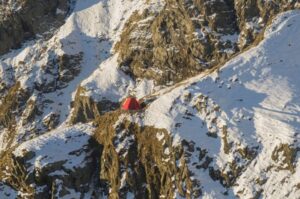On New Year’s Day, 2001, my wife and I went for a ski on the Cascade Fire Road, a cross-country trail near Banff, Alberta. We’d recently moved to the Canadian Rockies, and this was our favorite cross-country route. The tracked trail followed a paved road (closed to traffic in winter) before veering uphill through the woods. You could go almost as long as you wanted; occasionally, we’d join friends and ski it at night, under a full moon.
We thought nothing of our ski that day — it was just one of dozens of outings there. But the following afternoon, word spread through town: A solitary skier had just been killed by a cougar on the Cascade Fire Road. The woman was skiing back to the parking lot, and was just 100m away when the big cat, which had been following her through the woods, hit her from behind, then killed her with a bite to the neck.
This was the first fatality from a cougar in the history of Banff National Park; in fact, the only one in Alberta. Alerted by other skiers, park officials came and found the animal still standing over her, and shot it. The cougar seems to have been healthy. It was just one of those wrong-place, wrong-time tragedies.

Tracks of a young cougar on a cross-country ski trail. Photo: Jerry Kobalenko
Although I’ve specialized in traveling and writing about the Arctic, my first book was on the natural history of North American big cats, including cougars. Attacks like the one on the Cascade Fire Road are incredibly rare: This had been one of only 20 fatalities since 1900. You’re 650 times more likely to be killed by lightning than by a cougar.
Nevertheless, the cougar — also known as the mountain lion, panther, puma and 39 other English names — is one of the most widespread big mammals in the world, ranging from Alaska to Argentina. It is one of only two animals in North America that may stalk and kill people (the other is the polar bear). So whether you’re doing a six-week canoe expedition or a one-hour day hike, it’s important to be aware that you are sharing the outdoors with an animal that you almost never see, but which often sees you.
The cougar’s main prey is deer, which suggests why incidents with them are so unusual: A two-legged human is just too different from a deer, elk or sheep to trigger a predatory response. We’re even more different from their snack food — porcupines, armadillos, marmots, stray dogs and cats. “A human standing up is just not the right shape for a cat’s prey,” one cougar researcher told me.
In some situations, people can become more tempting. Kids are more vulnerable than adults, not because they’re less able to fight but because their small size triggers interest. Trail runners and mountain bikers may seem to be fleeing and so provoke chase behavior. Many modern fatal and non-fatal attacks fall in one of these two categories. Crouching down when a cougar is around removes the deterrent vertical posture: One kid was killed kneeling near a pond to look at tadpoles; a trail runner was hit when he bent down to tie his shoe. One person was even attacked while riding a horse. In this case, the cat simply made a mistake: It tried to take down the horse and there happened to be someone on it.

Caught by a remote camera, two cougars return to a kill at night. Photo: Banff National Park
The key thing to remember about cougars is that they are ambush hunters. They rarely launch frontal attacks. I’m not aware of any fatal incidents where the victim saw the cougar coming. Typically, it hits from behind like a ton of bricks. Its initial strike is so powerful that the whiplash has broken the neck of elk and driven antlers into the ground. With its prey flattened, the cougar wheels around with lightning speed and delivers a precise bite to the back of the neck that severs the spinal cord and kills instantly. Unlike some predators, a cougar never eats its prey to death.
Avoid that initial hit and you’ll almost certainly survive by fighting back, despite a little scuffing up. In one crazy episode, a cougar crashed through the window of a remote cabin on Vancouver Island at night. It seized the occupant, a telephone lineman, by the wrist. The man managed to grab a kitchen knife and stab the cougar several times. He then fled to his boat and motored 10km to a neighboring cabin for help. When officials returned the following day, the animal was dead.
Others who’ve not been hit from behind have successfully fought off cougars with a pen knife, or even by sticking their fists into the cat’s mouth — anything to keep those powerful jaws away from the neck or the back of the head. Its claws are minor weapons; the cougar uses them to hold on or climb rather than to kill. Below, a trail runner from Colorado describes how he managed to survive a cougar attack earlier this year:
There is no one way to deal with wildlife. It depends on the animal. Grizzly encounters, for example, tend to be territorial conflicts, so a submissive posture — eyes averted, shoulders slumped — may defuse the situation.
With cougars, the opposite is true: You need to clamp your eyes on the cat’s eyes and never look away. Stand tall, be aggressive. If you can, throw something at it: a rock, a stick, a daypack. Projectiles don’t exist in nature, so something hurled at a predator is very confusing to it. In the clip below, taken last year on Vancouver Island, a man stares down a cougar that is clearly interested in him and is waiting for the man to make a wrong move, such as turning his back, running away or playing dead.
Incidents with cougars are most common in places like California and Colorado, where a growing human population runs with increasing frequency into an animal that would prefer to be left alone, and Vancouver Island. Near the beach town of Tofino, rural kids learn about cougars just as urban kids are streetproofed and schoolchildren in Los Angeles practice earthquake drills.
Vancouver Island not only has lots of cougars, but the deer prefer browsing the many clear cuts, which makes it hard for the big cats to sneak up on them. It must be tempting for the cats to establish themselves near the only small prey on the island — the dogs and cats and raccoons that hang around towns. In fact, most attacks on people have taken place in these locations rather than in wilderness areas.
To reemphasize: The odds of seeing one of these ghost cats, let alone having an incident with one, are miniscule. If you must worry, worry more about black widow spider bites or bee stings. Nevertheless, living with wildlife, or traveling through their domain, means always being slightly aware — keeping half an eye on the forested edge of a trail, for example, especially around dusk: their preferred hunting time. Because while most cougars have no interest in people, there are exceptions.
With the fatality that occurred on our cross-country ski trail, I first wondered whether the skier had bent over to take an item of clothing out of her day pack. She hadn’t. The animal was healthy. There seemed to be no reason for the attack. Perhaps some individual animals, like some people, are simply more prone to dangerous urges than others.






